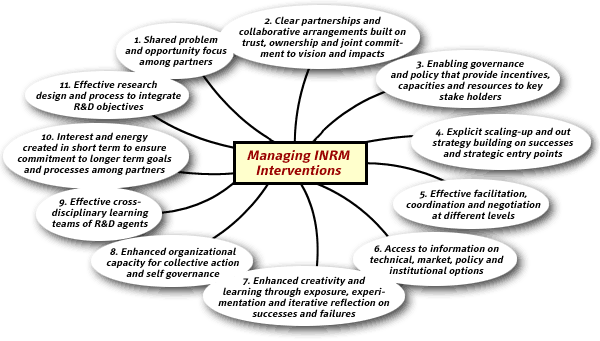







 |
 |

Managing INRM

 FIGURE 1: CORNERSTONES FOR MANAGING AN INRM APPROACH FIGURE 1: CORNERSTONES FOR MANAGING AN INRM APPROACH
(Campbell, Hagmann, Stroud 2003)
Managing Integrated Natural Resource Management (INRM) is basically an evolution of previous approaches and embodies ecoregional, agro-ecosystem, participatory, and livelihood dimensions:
- to embrace the complexity of sustainable improvement of productivity through the integration of NRM and productivity concerns
- to emphasize human decisions as causal factors that impact biophysical processes such as land abandonment
- to use multi-level hierarchical approaches encompassing site-level to wider systems and recognizing human decisions at different levels, from farm household to local to national and even global levels
- to link research with externalities such as policy and development actors incorporating these elements into the approach
- to highlight the role of the social sciences in understanding the social and policy dimensions to sustainable agricultural development and the balance needed between social and biophysical sciences in ecoregional research
- to pursue working relationships (e.g. multi-disciplinary teams) that could enhance the examination of a number of resource management themes—such as soil water relationships, soil fertility and plant protection and pursue the complementarity of institutional skills across IARCs, NARIs, Universities, NGOs and farmers organisations as a rationale for increasing partnerships
- to use a more holistic, systems approach as well as a research to development continuum to reflect a scientific sequence of characterization and diagnosis, technology development and extrapolation of successful solutions
This approach still explicitly embraces participation but has added dimensions to it beyond the farmer:
- to explicitly empower and build the capacity of resource managers and users recognizing that change and development required specific adaptations that are under their control
- to increase the level of dialogue and deliberation among stakeholders, improving interactions between research and "clients"
- to deal with high levels of uncertainty, non-linearity, and time lags, involving multiple scales of interaction and response, with multiple stakeholders with contrasting objectives and activities
- to incorporate and facilitate social learning processes for various actors and their organizations, including community and research entities
- to facilitate trade-off analyses, exchange and negotiation among stakeholders having different stakes/perspectives to resolve conflicting interests and promote benefit sharing
- to use systems and multiple level perspectives through scenario analyses and use of other participatory, analytical tools or models to improve decision making and selection of options
- to generate and integrate complementary policy, technological and institutional alternatives that have a direct bearing on the problem or opportunity
- to empower relevant stakeholders, applying organizational development and change principles, to strengthen collective and individual decision making, analysis, planning and implementation, lobbying, negotiation and conflict management
- to recognize and take into account that activities, the actors and their relationships link across various scales (farm-landscape-watershed) and levels (households-community-district-national)
The development and application of the INRM approach (see Figure 1) implies the integration of perspectives and expertise from various quarters using an "innovation systems"1 concept, e.g. incorporating researchers with different disciplines, government decision makers, community members, and from the development actors including extension, NGOs, and CBOs using teams and partnerships. INRM is meant to ensure that research is aimed at solving development problems and addressing opportunities by integrating disciplinary methods and tools, developing and using new participatory action research methods, and providing feedback to guide component or factor research. The approach is aimed at solving a complex of poverty-livelihood-environmental issues in practical ways; e.g. by focusing on key causal elements, assets, and their interactions. It deals with these efficiently and effectively using a more holistic approach, but starting with most limiting factors and important felt needs (entry points).
1 "Innovation systems" refers to all of the actors and actions required to make an innovation (an approach, technical improvement, an enterprise) work. It precludes that facilitation of the process is needed, that is, to ensure that the various actors and actions take place in iteratively or as a sequence over time for the innovation to materialize. Technology development is one example where multiple sources of ideas for design, various adaptations by users, and testing and assessment are required so as to develop the final product.

|
 |